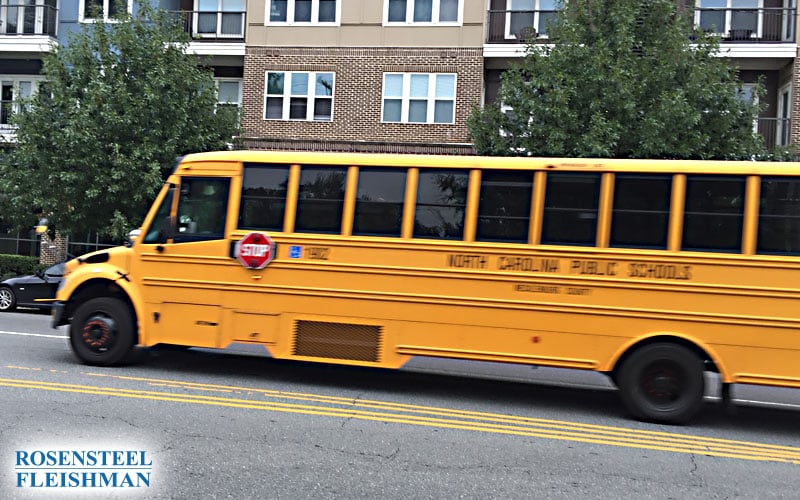Back pain after an accident can leave anyone feeling unsure about what comes next, especially when symptoms appear slowly or feel worse as the days pass. Many people try to deal with the discomfort on their own, but when the pain starts to interfere with work, sleep, or simple daily tasks, it becomes clear that […]

Back to School Safety
Children across the United States have settled back into school. They are involved in after-school activities and sports. That means that any given time throughout the day, the roadways and sidewalks are more crowded than usual. There are more children walking or bicycling to and from school, more parents driving their kids to or from school or to sports or other activities, newly licensed teenagers driving to and from school and activities and school buses. Unfortunately that also means more car, pedestrian and bicycle accidents.
Pedestrian Accidents
Data released by the National Highway Safety Transportation Administration (NHTSA) for 2019, the most recent available, shows the following for pedestrian accidents involving kids:
- 57 children under the age of 5 were killed
- 46 children between the ages of 5 and 9 were killed
- 103 children between the ages of 10 and 15 were killed
- 218 young adults between the ages of 16 and 20 were killed
Until 2013, the number of pedestrian deaths involving children was on the decline. It has risen significantly since that time. This increase has been attributed to a number of factors including distraction and engaging in unsafe behaviors.
Tweens and teens in particular, who account for the largest number of pedestrian deaths, are more likely to be distracted while walking, oftentimes looking down at their phones and texting while walking and therefore not paying attention. People walking and texting or looking at their phones are more likely to cross the street without looking up and more likely to be hit and injured by a car. In addition, more and more children are using headphones or earbuds while walking which is not only distracting but limits their ability to hear oncoming traffic or cars who may honk to warn them if they step out into the road or engage in other unsafe behavior.
A Safe Kids Worldwide observational study showed that in addition to distracted walking, teens and tweens are more likely to engage in unsafe behaviors while crossing the street including:
- not crossing at a corner or designated crosswalk
- failing to look both way before crossing the street
- ignoring traffic signals indicating that they should not cross
School Bus Safety Rules
According to the NHTSA’s data, school buses are safer than cars. The NHTSA estimates that children are 70 times more likely to arrive at school safely if they are traveling on a school bus. However accidents still happen involving school buses and often as a result of motorists not following the law when they encounter a school bus. In every state in the United States it is illegal to pass a stopped school bus. In spite of this, estimates show that motorists illegally pass school buses 15 million times per year.
North Carolina drivers should be familiar with the law when in a school zone and when encountering a school bus that is stopped, or stopping. If traveling to a different state, it is important to be familiar with the school bus laws in that state. The following are rules that all North Carolina drivers must follow when encountering a stopped school bus:
- Two-lane roads. Cars on both sides of the road, coming from either direction, must stop. If there is a center turn lane, all traffic from either direction must still stop.
- Four-lane roads. If there is no median in the center of the road, then all traffic (coming from both directions) must stop. If there is a median in the middle of the road, or a center turn lane, then only the traffic traveling in the same direction as the school bus must stop.
Often school buses indicate that they are preparing to stop first by putting on their flashing yellow lights. That is an indication to nearby drivers that they should slow down and be prepared to stop, not that they should speed up and try to get past the bus before the red lights or extended stop sign or arm come out.
School buses are large vehicles and it is not always easy for the driver to see children, therefore, in addition to cars having to follow the above rules of the road, children and their parents should take certain steps to avoid being hit by a bus or a car. These include:
- Looking carefully before getting off the bus and crossing the road. If a child has to cross the road, they should always cross in front of the bus. Often the bus driver will signal to the child that it is safe to cross. If a parent is waiting at the bus stop, they should wait on the side of the road where the child gets off the bus, not make the child cross the road.
- Stand on the sidewalk, or off of the main part of the road if there is no sidewalk, when waiting for the bus. This ensures that both the bus and other drivers see the child.
- Watch the driver. If a child has to cross a street to get on the bus, he/she should wait for the driver to signal that it is okay for him/her to cross the road.
Drivers who fail to follow school bus safety rules and injure or kill someone could find themselves subject to a personal injury or wrongful death suit. In addition, North Carolina law imposes the following:
- For motorists who pass a stopped school bus - a $500 fine and 5 points on their license
- For motorists who hit someone while passing a stopped school bus - a minimum fine of $1,000 plus a Class I felony charge
- For motorists who kill someone while passing a stopped school bus - a fine of $2,500 and a Class H felony charge
Why Do I Need a Charlotte Law Firm?
Pedestrian accidents and car accidents happen frequently. The Charlotte, NC based lawyers at Rosensteel Fleishman Car Accident & Injury Lawyers are experienced pedestrian and car accident attorneys who can help you understand your rights and whether or not you have damages and should proceed with a claim. Please contact our office at 704-714-1450. There is no fee for an initial consultation.
Additional Car Accident Law Articles Personal Injury Articles
After a serious motorcycle accident, many people feel overwhelmed by the sudden change in their daily life. The physical pain is one part of it, but the confusion that comes after a severe crash can be just as difficult to manage. It often feels like there is no clear direction, especially when medical appointments, lost […]
Pain and loss can change the way your days feel. When you are dealing with the stress that comes after an accident, it is easy to feel unsure about what steps to take next or how to protect yourself. Medical appointments, missed work, and the emotional weight of the situation can make everything feel heavier. […]
When a person is struck by a car, life can feel instantly shaken. There is confusion, worry, and the immediate pressure of figuring out what to do next. Many people in Charlotte find themselves unsure of how to handle the situation, especially when injuries are involved. Even simple tasks feel overwhelming, which is why having […]
